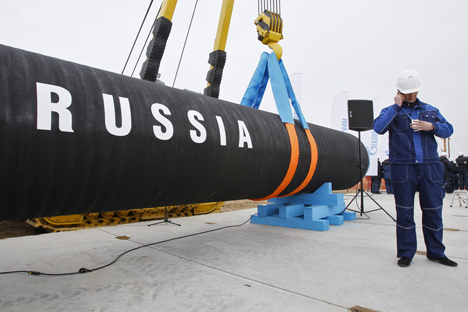
Gazprom hopes to increase supplies to Europe, as its main competitors redirect their deliveries to the “premium” markets of the Asia-Pacific Region. Source: AP
Gazprom plans to export to Europe more than 160 bcm (5.6 trillion cubic feet) of natural gas in 2013, Gazprom CEO Alexey Miller told the Annual General Meeting on Friday, June 28.
According to him, Gazprom sold 139.9 bcm of natural gas to European consumers in 2012 (see the chart) under long-term contracts, while total sales amounted to 151 bcm.
Back in February, Gazprom’s forecast was a moderate one, projecting growth to 152 bcm this year.
The monopoly has revised its forecast, building on its performance in the first half of 2013, when exports totaled 80 bcm of natural gas, up 10 percent from the previous year.
Gazprom hopes to increase supplies to Europe, as its main competitors redirect their deliveries to the “premium” markets of the Asia-Pacific Region, and while Europe’s own gas production is falling, Miller said.
Turkey may become the biggest importer of Russian natural gas, leaving Germany behind. Turkey has become the fastest-growing market for Gazprom.
Last year, it became the second-biggest buyer of Russian natural gas and, this year, “it’s snapping at Germany’s heels,” said Miller.
According to his estimates, Gazprom’s annual gas supplies to Turkey may soon reach a new all-time high of 30 bcm.
East European Gas Analysis has reported Turkey’s gas imports to have been 43 bcm in 2012, including imports from Russia of 27 bcm—more than half the total.
It would be a bit too optimistic to hope for an increase in the monopoly’s market share in Europe based on the forecast for Turkey alone, warns Mikhail Korchemkin, director of East European Gas Analysis.
“In Jan.-May, Turkey’s gas consumption fell by 17 percent year-on-year; Gazprom’s sales in the region were falling, except for the Iranian market,” he said.
Gazprom has also reported progress in its talks with German buyers. It took the gas giant a year to resolve the conflict with RWE. The two companies had negotiated discounts for about a year, but they managed to settle only in court.
Last week, an international court of arbitration ruled that Gazprom had to pay the German company the price difference accumulated since May 2010. Neither company has commented on the court decision or the size of the payment.
A source close to Gazprom says the monopoly will have to pay €1.5 billion ($1.9 billion) by the end of the year. Alexander Medvedev, deputy CEO of Gazprom, told Vedomosti that the company would comply with the ruling.
Furthermore, Gazprom will soon announce completion of talks over price adjustment with some other European importers, Medvedev promised the shareholders.
Another chance for the company to increase its European share is the trend involving its rivals redirecting their supplies to Asia.
Miller said that gas deliveries to Europe from other exporters had dropped in the first quarter. Algeria is cutting supplies to Europe by 10 percent, Libya by 12.9 percent and Qatar by 42 percent.
Gazprom expects no shortages of raw material: As soon as the Bovanenkovo deposit becomes operational, Gazprom’s total annual production capacity will increase to 600 bcm.
By 2030, Gazprom plans to increase its share in Europe to 33 percent from the current 26 percent (it originally planned to raise its share to 32 percent). Whether or not the monopoly will succeed depends on the price of coal, which is increasingly used in power engineering instead of natural gas.
In the long term, Gazprom’s success will also depend on its peers’ policy toward Europe — especially the companies that are currently developing deposits in the Mediterranean, Korchemkin said.
Gazprom also plans to triple its share of the global liquefied natural gas market to 15 percent.
Gazprom announces new LNG project
Russia to cancel Gazprom’s liquefied gas export monopoly
“It is the APR [Asia-Pacific Region] that is projected to have the fastest-growing demand for LNG, and it is that region that will be the focus of our expansion of our export markets. We will boost our presence in the APR primarily through an increase in our own production,” Miller said.
Gazprom operates Russia’s only LNG plant, Sakhalin-2, with an annual capacity of 10 million tons; it supplies about 70 percent of its output to Japan. There are plans to boost its capacity by 5 million tons.
Gazprom is also preparing two more LNG projects: Vladivostok-SPG in the Primorsky region and Baltiysky-SPG in the Leningrad region (each capable of producing 10 million tons of LNG annually); both plants are expected to be launched by 2019.
First published in Russian in Vedomosti.
All rights reserved by Rossiyskaya Gazeta.
Subscribe
to our newsletter!
Get the week's best stories straight to your inbox